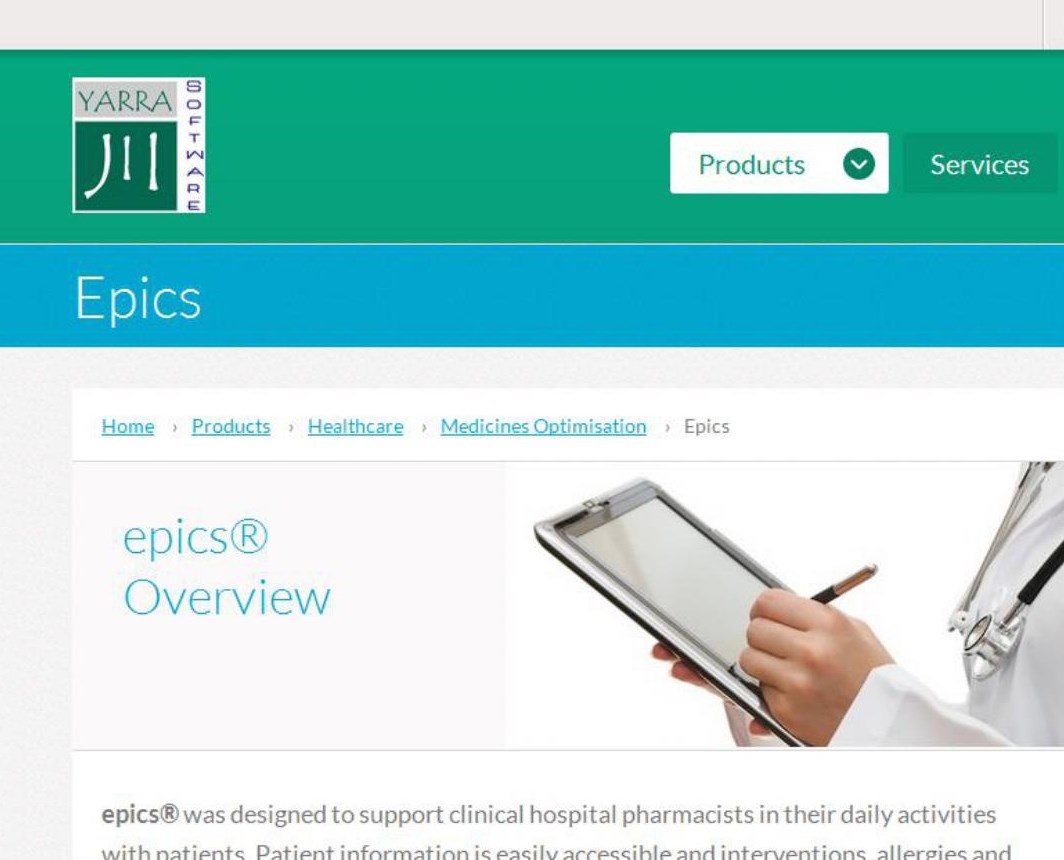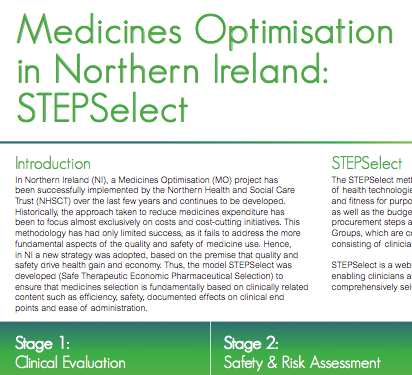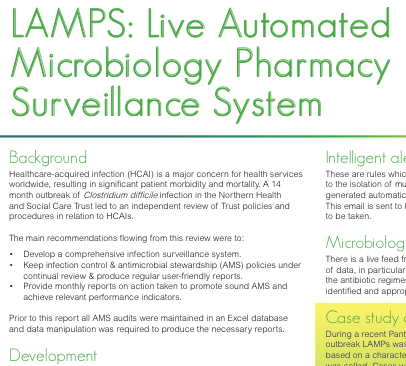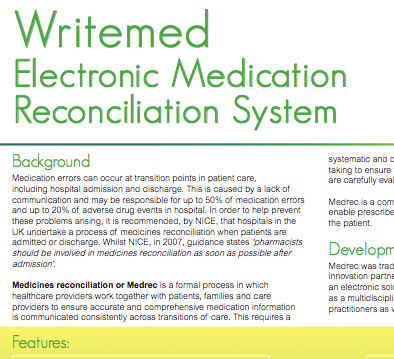
by MOIC | Mar 1, 2016 | Products
Electronic Pharmacist Intervention Clinical System
Patient safety in Northern Ireland can be enhanced via the use of EPICS (Electronic Pharmacist Intervention Clinical System). This novel software package, designed in conjunction with a local software company, enables pharmacy staff to record in real-time their clinical activities and clinical interventions (any action taken to correct a problem identified in a patient’s medications). These recorded interventions are archived for subsequent analysis. NHS data standards such as the dictionary of medicines and devices (dm+d) and the National Patient Safety Agency (NPSA) risk matrix are already fully integrated into EPICS and the software is designed to be compatible with NHS computer systems UK-wide.
Learning from data
EPICS provides an agreed, comprehensive, consistent approach to recording clinical pharmacy data in a digital format. This standardisation of data ensures that every user is recording the same information in the same way at every site, while the paperless format helps to protect confidentiality and avoid data loss. This combination of both uniformity of approach and digital format means that data can be analysed quickly and easily at both local and regional level to allow meaningful benchmarking. With this in mind a suite of reports is available which can analyse the data at both the quantitative and qualitative levels.
EPICS can be linked to hospital incident reporting systems (e.g. DATIX) to improve learning from critical incidents in line with NPSA best practice. EPICS is designed to identify problem medications, the early detection of emergent trends, and to promote systemic learning so that ‘… the risk of avoidable harm to patients is minimised’ in line with the aspirations of An organisation with a memory.
Four of the five Healthcare Trusts in NI are already using EPICS. Work is currently on-going to extend the reach of EPICS into community pharmacies in primary care. This will make clinical governance and medicines management tools available to pharmacists across the healthcare continuum in both primary and secondary care. This extension would ensure a fully integrated optimal medicines management system utilising standard technologies. This would have significant benefits for improving safety & quality of patient care, continuity of service and health analytics.

by MOIC | Mar 1, 2016 | Products
Historically, the approach taken to reduce medicines expenditure has been to focus almost exclusively on costs and cost-cutting initiatives. This has had only limited success, as it fails to address the more fundamental aspects of the quality and safety of medicine use.
In conjunction with our collaborators, the STEPSelect programme (Safe Therapeutic Economic Pharmaceutical Selection) has been developed. This system ensures that medicines selection is fundamentally based on clinically related content such as efficacy, safety, documented effects on clinical end points and ease of administration. STEPSelect is a web based tool developed by Digitalis Mm Ltd, enabling clinicians and other health care providers and managers to comprehensively select and procure medicines and medical devices.
Transparent process
The STEPSelect method looks in first instance at clinical features of health technologies. At a later stage of the evaluation, product quality and fitness for purpose are assessed (the so-called risk assessment stage) as well as the budget impact of a health technology and appropriate procurement steps and routines. Evaluations are carried out by Expert Groups, which are composed on the basis of a multidisciplinary nature consisting of clinicians, pharmacists, nurses and other staff as appropriate. The STEPSelect method has been used for a number of drug classes including erythropoietin stimulating agents and granulocyte colony stimulating factors and has now been extended to include dressings and medical and surgical devices. The outcomes of the process are used to produce guidance and to assist in formulary management. This can then be used to inform electronic decision support at the point of prescribing.
Stage 1: Clinical Evaluation
- Literature evidence compiled by professional editorial network of Digitalis
- Review evidence supplied by Pharmaceutical Industry, additional to the literature review (STEPSelect) and best evidence
- Assign relative weights to each selection criteria and scores to each product
- Ranking of chemical entities to proceed to Stage 2
Stage 2: Safety and Risk Assessment
- Product samples obtained from Industry
- Assessed using modified versions of national QC and Risk Assessment tools for Medicinal Products: Product Quality and Fitness for Purpose (PQFFP) and Medicines Error Potential Assessment (MEPA)
- PQFFP (Pass/Fail); MEPA (Low, Medium, High)
- Ranking of chemical entities and MEPA scores to proceed to Stage 3
Stage 3: Budget Impact Analysis
- Annual usage data obtained to allow comparison of products within the same class
- Ranking of chemical entities to proceed to Stage 4
Stage 4: Contract & Guidance
- Guidance produced to inform the service of products suitable for prescribing first line
- Relevant contracts put in place
Efficiency gains
In NI the STEPSelect technology has been applied to procurement of medicines in many different therapeutic groups such as statins, erythropoietin stimulating agents (ESA’s) and the use of biologicals in rheumatoid arthritis. Results with the method have invariably been positive in terms of support by clinicians and quality and cost reductions of prescribing, often in the region of 20-25% per therapeutic group.
Benefits:
- Reduced medicines related adverse events
- Improved Quality: Drug selection based on safety & efficacy, then cost
- Improved Efficiency: Cost-effective drug selection, reduced stockholding and reduction of out of date stock
- Robust, transparent, defensible process
Interactive website:
- Tablet devices for Expert Group members
- Project mentor
- Project key for limited access for special target groups
- e-Sessions to highlight choices for special interest groups
- Comprehensive stakeholder input via these interactive mechanisms
Summary:
- Supports a clinical driven procurement process
- Process is based on the principles of quality and safety
- Supports guidance and formulary development and maintenance
- Maximises health care resource utilisation
- A key component of Medicines Optimisation
MOIC STEPSelect Poster

by MOIC | Mar 1, 2016 | Products
Live Automated Microbiology Pharmacy surveillance
Healthcare Acquired Infections (HCAIs) are a key concern for all health organisations worldwide, resulting in significant patient morbidity and mortality. A fourteen-month outbreak of Clostridium difficile in the Northern Health and Social Care Trust led to an independent review of Trust policies and procedures in relation to HCAIs. The main recommendations flowing from this review were to:
- Develop a comprehensive infection surveillance system
- Keep infection control and antimicrobial stewardship (AMS) policies under continual review and produce regular user-friendly reports
- Provide monthly reports on action taken to promote sound AMS and achieve relevant performance indicators.
A multidisciplinary team was established to address these recommendations. The team included microbiology consultants, pharmacists, infection control nurses and representatives from a local company, Yarra Software Ltd. A new, bespoke solution for antimicrobial surveillance, Live Automated Microbiology Pharmacy Surveillance system (LAMPs) was developed.
Practical applications
Antimicrobial stewardship: Weekly audits of adherence to antimicrobial policies and the use of all restricted antibiotics within the Northern Health and Social Care Trust are entered by clinical pharmacy teams on the ward. After validation of the data by both the antimicrobial pharmacist and microbiologist, the software produces various graphs. These are available promptly for inclusion in quarterly reports for the Antimicrobial Management Team and Infection Prevention Control and Environmental Hygiene Committee. The software automatically generates and emails an Excel spreadsheet of the data on a monthly basis to the antimicrobial pharmacist. This facilitates production of stewardship reports to be made available to the ward Medical, Nursing and Pharmacy staff.
Intelligent alerts: Intelligent alerts are rules which are defined and can be modified by the user. Alerts to the isolation of multi-drug resistant bacteria are set and an email is generated automatically by the system 24 hours a day, 365 days a year. This email is sent to key recipients thereby enabling rapid remedial action to be taken.
Microbiology epidemiology: A live feed from laboratory software allows real time analysis of data, in particular organism sensitivity and resistance patterns to the antibiotic regimes being used. This enables resistance trends to be identified and appropriate steps taken to address.
In the future the aim is to extend LAMPs across Northern Ireland in order to achieve a fully integrated surveillance system incorporating both primary and secondary care.
MOIC LAMPs Poster

by MOIC | Mar 1, 2016 | Products
Electronic Medication Reconciliation System
Lack of communication at transition points in patient care may be responsible for up to 50% of medication errors and up to 20% of adverse drug events in hospital. To help prevent these problems it is recommended by NICE that hospitals in the UK undertake a process of medicines reconciliation when patients are admitted and discharged.
Along with commercial partners, an electronic system for medicines reconciliation has been developed. This system ensures uniform recording of patient medication details in real time and the medication description is populated from the NHS dictionary of medicines and devices (dm+d). Any issues with regards to the patient’s medicines at admission are addressed and any changes made during their hospital stay are accurately recorded.
Integrated process
The medication information recorded on the system is used to form the basis of the discharge medication list. This list is pre-populated from the medicines reconciliation record, leading to decreases in transcribing errors and the use of uniform descriptions with legible instructions. The information, at discharge, is integrated into the Trust’s patient centre system and can be accessed as a document in the patient’s electronic care record (ECR). It is also forwarded to primary care and is accurate in relation to medicines, taking account of all changes, together with reasons, that occurred during the hospital stay.
The system can be interrogated to produce reports to analyse the information recorded. This system links with the pharmacist intervention system (EPICS) and in the future will be linked with the Trust incident reporting system (DATIX), ensuring an integrated process for the pharmacy team. This greatly improves the safety and quality of medicines used in treating patients. The next stage will be full electronic uptake into primary care systems to give a fully integrated cohesive system for medicines management which ensures accurate communication across the interface.
MOIC Writemed Poster




